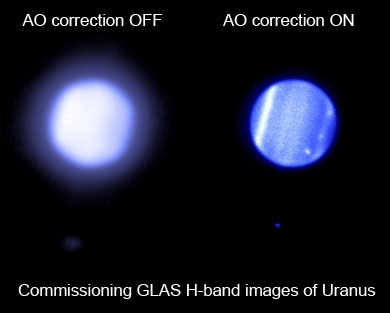Director's Corner
14 August 2008
 Barry Barish |
Spain's increasing involvement in large international science
Did you know that Spain joined CERN as a Member State in 1961, but left seven years later? The modern era in Spanish particle physics was marked by Spain rejoining CERN in 1983, and the country’s investments and programme in particle physics have continued to grow and thrive ever since. This is not the only large investment in Spanish science: I recently had the opportunity to visit the astronomical facilities at 2200 metres altitude on the Spanish island of La Palma, one of the Canary Islands. The La Palma Observatory is interesting to us in the ILC as we study examples of how international collaborations work for large science projects in preparation for developing our own models of international collaboration for the ILC. The Roque de los Muchachos Observatory on La Palma has it all: the largest segmented telescope in the world (10.4 metres and built by Spain), advanced technical developments in adaptive optics that are extending the science programme of the
4.7-metre Isaac Newton Group telescope and an important high energy gamma ray telescope, MAGIC, with a 17-metre reflecting surface to detect Cerenkov radiation from gamma ray induced showers by focusing the Cerenkov radiation.
 Roque de los Muchachos Observatory on La Palma at sunset Roque de los Muchachos Observatory on La Palma at sunset |
 Laser guide star aided adaptive optics for the 4.3 m telescope Laser guide star aided adaptive optics for the 4.3 m telescope |
 The 10.4-metre Gran Telescopio Canarias The 10.4-metre Gran Telescopio Canarias |
In June, I participated as a guest speaker in the "Campus of Excellence" programme organised by the University of Las Palmas de Gran Canaria and the Vitalia Foundation, a non-profit organisation created for running academic and cultural events in the Canary Islands. The programme is energetically directed by José R. Calvo, who brings together a prominent set of lecturers and panelists from science and government, providing an interdisciplinary event that covers a diverse set of subjects related to science and society for about 100 graduate students chosen from around the world. At our request, the meeting organisers arranged a long one-day flying-driving excursion that enabled a group of us to visit the European Northern Observatory on the remote island of La Palma. This was very informative and a most enjoyable day!
La Palma is one of the seven major volcanic islands called the Canary Islands, a part of Spain that is located in the Atlantic Ocean about 100 kilometres off of the west coast of Africa. The La Palma volcano rises almost 7 kilometres above the ocean floor and is alleged to be the steepest island in the world. There is road access from the airstrip to the very top, which we traversed through changing vegetation marking the different altitudes all the way to the summit at 2421 metres. The summit is part of the rim of a giant 9 kilometre wide and 1.5 kilometre deep crater where the various telescopes of the observatory are located - a most spectacular site. This is a near-perfect location for astronomy and it has therefore attracted a large set of modern astronomical instruments, ranging from solar to giant telescopes. The air is typically very dry and the clouds form between 1000 and 2000 metres, making for a very clear sky at the telescopes above the cloud layer.
The workhorse telescopes at the observatory have been the Isaac Newton Group (ING) that includes the 4.2-metre William Herschel Telescope. That telescope has an ambitious adaptive optics system to correct for the effects of scattering of light in the atmosphere and a laser guide star system to enable larger sky coverage. The ING is an international collaboration between the Science and Technology Facilities Council (STFC) of the United Kingdom, the Nederlandse Organisatie voor Wetenschappelijk Onderzoek (NWO) of the Netherlands, and the Instituto de Astrofísica de Canarias (IAC) in Spain. Recent scientific results include comparisons of eight examples of populations of galaxies falling towards the centres of galaxy clusters with control samples of galaxies far from the clusters. The collaboration found that the infalling galaxies in the cluster were predominantly distorted in shape and had higher than normal rates of star formation, suggesting the conditions needed for slow galaxy interactions and mergers are more likely to occur in galaxies falling into a galaxy cluster compared to the general population of galaxies outside clusters.
The ambitious Gran Telescopio Canarias (GTC), nicknamed GranTeCan, is at present time the largest reflecting telescope in the world with its 10.4 metres diameter. This around 130-million-Euro construction project represents a major investment in science by Spain, and the facility includes collaboration with institutions from Mexico and the University of Florida.
Another major facility at the observatory is MAGIC (Major Atmospheric Gamma-ray Imaging Cerenkov Telescope), a high-energy gamma ray telescope that detects Cerenkov radiation from particle showers released by cosmic gamma-rays. MAGIC has a 17-metre diameter reflecting surface, the largest in the world. MAGIC is sensitive to cosmic gamma rays with energies between 50 GeV and 30 TeV and will work in conjunction with the Gamma-ray Large Area Space Telescope GLAST recently launched into space to study sources of high-energy gamma rays. A second MAGIC telescope (MAGIC 2) located 85 metre away is almost complete.
In addition to these astronomical facilities, Spain has started a major third-generation light source project, ALBA, near Barcelona costing nearly 200 million Euros. They also have significant involvement in the LHC and have recently joined the ILC. Spain is very ambitious towards attracting large international projects and was a serious bidder to host ITER before France was selected. They are presently one of three countries bidding to host the more than 1-billion-Euro European Spallation Neutron Source (ESS).
We fully expect Spain to play an important developing role in the ILC. The next meeting of the Funding Agencies for Large Colliders (FALC) will be hosted by Spain and held in Madrid next January. We plan to use that opportunity to arrange separate meetings with Spanish physicists and authorities where we will explore furthering our collaborations with Spain leading toward the ILC.
-- Barry Barish
